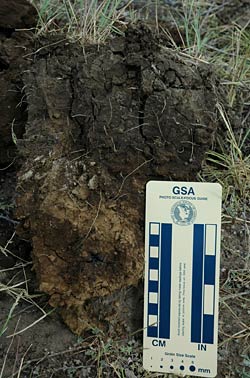
Soil mixing occurs in Vertisols due to shrink/swell processes
Vertisols are heavy textured soils (with ≥ 60% clay) with shrink-swell characteristics. They lack the horizon development diagnostic of other horizons. Slickenslides and argillipedoturbation (disruption and mixing caused by shrink-swell of the soil mass) are diagnostic features of these soils. The horizons that result from this mixing are inverted of material and are called vertic horizons (e.g., Bv, Cv). As a mass of soil is displaced along a crack, the face of the mass can become very smooth and polished and these polished surfaces are called slickenslides. The horizons in which slickenslides are Bss, Ckss, or Cgss.
There are two great groups of the Vertisolic order. Both have B and/or C horizons with evidence of mixing (Bv or Cv) and polished surfaces along fracture planes (Bss or Css). The differences between them are based on how well expressed the A horizon is.
Humic Vertisol Great Group
These soils have an Ah (or Ap) horizon thicker or equal to 10 cm and a darker A horizon than the Vertisol great group. The colour value of the horizon must be less than 3.5 (dry).
Vertisol Great Group
Soils of the Vertisol great group have an A horizon less than 10 cm thick that can be difficult to distinguish from the underlying B or C horizon. The colour value of the horizon is ≥ 3.5.